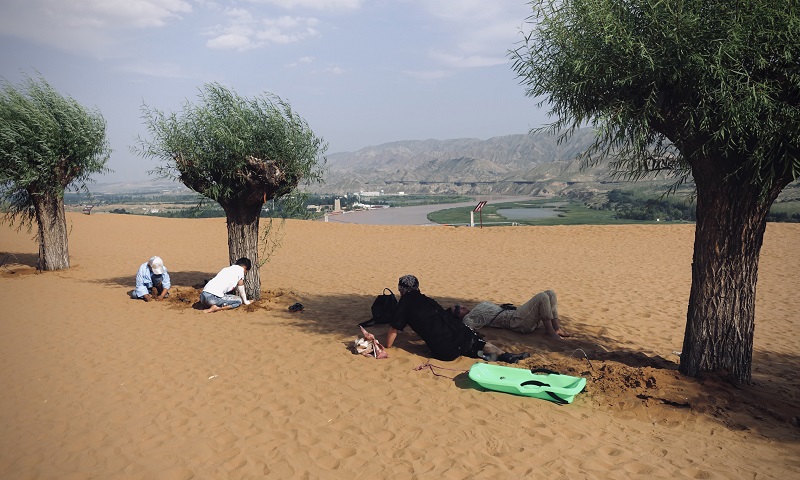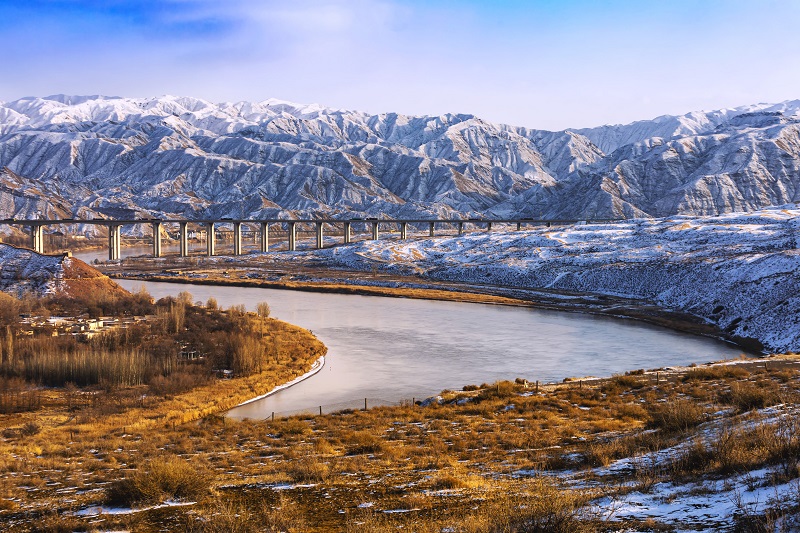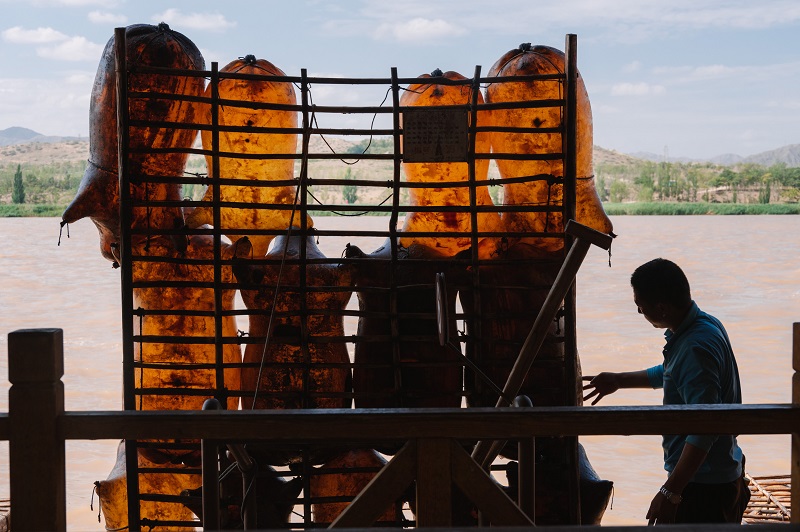"From barren wastelands draped in sand, a plume of smoke rises, past the long river the round sun sinks low.” Wang Wei, a poet of the Tang Dynasty (618-907), wrote those verses about the desert landscape more than 1,000 years ago to describe his awe at the spectacular scenery of Shapotou. The ancient Yellow River rushes through the mountains and valleys, but after a sharp bend at the Black Mountain Gorge, the churning torrents merge into a calm and serene river and flow into the city of Zhong-wei in northwest China’s Ningxia Hui Autonomous Region, where the water nourishes fertile lands around the riverbanks and creates the magical natural landscape of Shapotou.
Shapotou boasts a range of mesmerizing natural attractions in a desert landscape. It has China’s largest natural sand sledding field, and an 820-meter aerial ropeway which traverses the Yellow River. Symbols of the Yellow River culture, the world’s first railroad that runs through the desert — the Baotou-Lanzhou Railway, and one of the oldest means of transportation on the Yellow River — the sheepskin raft, can be found here. Here, tourists can ride camels on the sea of sand, or go over the dunes by cross-country vehicles. Another interesting attraction is the numerous straw checkerboards, a compelling and long sought-after solution to desertification.
Today, Shapotou is a national nature reserve as well as a scenic area located just 16 kilometers west of the city of Zhongwei. It sits on the southeast rim of the Tengger Desert, covering an area of 4,599.3 hectares south of the Yellow River, at an elevation between 1,300 to 1,500 meters. It is also a national 5A tourist attraction and national desert nature reserve.

Visitors to the Shapotou Scenic Area experience China’s western region culture by taking a ride on sheepskin rafts down the Yellow River.
Sheepskin Rafts and Waterwheels
Shapotou is composed of two sections; the south is the Yellow River zone and the north is the desert zone. In the Yellow River zone, visitors can experience the beauty as well as the culture of the Yellow River in an up-close and immersive manner. One must-have experience is a ride on the rafting vessel native to the Yellow River, the sheepskin raft.
In the days before land transportation was mechanized, the sheepskin raft was widely used as the essential mode of transport for people living along the Yellow River, with a history of thousands of years. All the materials used for making the raft could be easily found locally and were mostly inexpensive.
Nowadays, a sheepskin raft for tourists in Shapotou consists of two dozen air-filled sheepskins, with a carrying capacity of up to a ton, and able to carry three to four people on board. Driven by seasoned sailors who have been working on the Yellow River all their lives, rafts cruise safely down the river while tourists on the rafts can enjoy all the scenic landscapes along the route.
On the waterway, there are two wooden waterwheels erected along the Yellow River, which local farmers once used to irrigate fields for generations. Waterwheels that are eight meters high are discernible from the foot of the Duo Lion Mountain. Driven by the flow of the river, the waterwheels’ rotating wood plates channel water to the field whose produce supports the whole village.

Children and grown-ups are enjoying their time relaxing on the sands of the Mingsha Mountain at Shapotou.
Mingsha Mountain
Another highlight in Shapotou is the Mingsha (literally meaning singing sand) Mountain. During the reign of Qing Emperor Qianlong (1711-1799), a massive dune formed by the Yellow River. It is 2,000 meters wide and approximately 100 meters long. When the sky is clear and temperatures rise, the sandy slope creates a unique buzzing sound when people sled over it. The sound resembles a bell toll, so it is known as “bell ringing.”
Visitors can experience the thrill of sand-sledding at the Ming-sha Mountain. The slope is 180 meters long with a vertical drop of 72 meters and a 35 degree incline. Brakes are mounted on both sides of the sled, so that if a rider feels nervous or scared, they can pull the brakes to slow down the sled. A thrill-seeker, by contrast, can let go of the brakes to experience the thrill of a high-speed descent down the slope at an incredible speed. The Mingsha Mountain is also an excellent spot for scenery viewing. On the top of the slope, tourists can take pictures and overlook the Yellow River; after sliding down, people can stand at the bottom and look up at the towering waterfall-like sand mountain.
If sand sledding is the most fun that can be had on the ground, then the Yellow River ropeway provides similar thrills but in the air. Riders traveling across the Yellow River by pulleys hanging by a cable can view the golden desert and the Yellow River from the air, get a thrill of the high altitude, and enjoy the wild northwestern scenery.

A stunning view of the Yellow River at Shapotou after a snowfall.
An Off-Road Playground
An endless expanse of the Tengger Desert abuts Shapotou in the north, stretching out as far as one’s eyes can see. Tourists can traverse the rolling sand dunes either on camels or by desert buggies and other cross-country off-road vehicles. Visitors find themselves awed by the desert landscapes just as the poet Wang Wei was over 1,000 years ago.
Camels are an important means of transport in the desert. At Shapotou, a fleet of camels led by their stewards roam the desert. The sound of a bell ringing across the vast silence of the desert makes the camel riders feel like a single grain in an ocean of sand.
Driving cross-country vehicles is another popular recreational activity in the desert. Racing freely over rolling dunes, riders can get a thrilling taste of the wilderness of the desert as sand hits their cheeks and their hearts thump with adrenaline as they hurl over dunes.
Children who are too young to travel on off-road vehicles can still enjoy the sand as it is like a natural playground for them. Equipped with their own various toys and tools, they can have a great time playing in the sand and even put their feet in it to get a feel for the desert heat.

Off-duty sheepskin rafts are resting by the Yellow River at Shapotou on July 23, 2021.
A Green Miracle
There is a Desert Museum in the scenic area displaying the major achievements that have been made in the battles against sand in Shapotou. Over the past half century, stretches of oasis have begun to creep across the land owing to the sweat, youth, and even lives devoted by three generations of researchers and workers.
In 1958, the Baotou-Lanzhou Railway was opened to traffic. Six sections of the rail line ran through the Tengger Desert, totaling more than 40 kilometers. In particular, the 16-km section in Shapotou was built in a region filled with tall flowing sand dunes with very low vegetation coverage. It was often attacked by quicksands. But back then, sand control for railroads was a great technological challenge globally. When a sandstorm hits, the rails built through great effort could be instantly submerged in the desert.
To ensure a safe train ride through the sand, in 1955, a team of experts led by famous geologist Zhu Kezhen came to Shapotou and established China’s first comprehensive desert management research station.
After numourous experiments, researchers found that a straw grid network, also known as straw checkerboard, can effectively prevent the dunes from moving around. The one-by-one square meter grid is made from wheat straw and rice straw tied onto the surface of mobile dunes. They are like guards in the sand ocean who build a grass wall to confine the quicksand. The checkerboard used for sand control is now famous in the world. Based on the straw checkerboard technique, a composite system has taken shape, with the functions of fire prevention, forestation, grass barrier, and sand fixation. For more than six decades since its opening, the Baotou-Lanzhou Railway has never once been cut off by moving sand.
Sitting adjacent to the Yellow River, Shapotou has a wide array of varying scenery to offer, consisting of waterways, mountains, the desert, and green fields where the Yellow River culture has thrived for thousands of years.